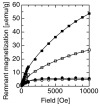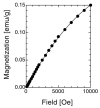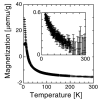Preliminary observation of elevated levels of nanocrystalline iron oxide in the basal ganglia of neuroferritinopathy patients
- PMID: 17097860
- PMCID: PMC1993816
- DOI: 10.1016/j.bbadis.2006.09.011
Preliminary observation of elevated levels of nanocrystalline iron oxide in the basal ganglia of neuroferritinopathy patients
Abstract
Magnetometry analysis of brain tissue sub-samples from two neuroferritinopathy patients provides a preliminary indication that the amount of magnetic iron compounds associated with this rare disease is significantly larger than in age/sex-matched controls. The primary iron compounds contributing to the remnant magnetization of the tissue above 50 K and at body temperature are both blocked and superparamagnetic (SPM) biogenic magnetite (Fe3O4) and/or maghemite (gamma-Fe2O3). The concentration of SPM magnetite is significant and appears to be proportional to the concentration of ferritin, which varies with progression of the disease. The mutated ferritin protein appears to be responsible for the presence of iron oxide nano-particules, which in turn could be responsible for extensive damage in the brain.
Figures




References
-
- Chinnery PF. Gene Reviews. 2005. available at ( www.genetests.org) searching for ‘neuroferritinopathy’.
-
- Curtis ARJ, Fey C, Morris CM, Bindoff LA, Ince PG, Chinnery PF, Coulthard A, Jackson MJ, Jackson AP, McHale DP, Hay D, Barker WA, Markham AF, Bates D, Curtis A, Burn J. Mutation in the gene encoding ferritin light polypeptide causes dominant adult-onset basal ganglia disease. Nature Genetics. 2001;28:350–354. - PubMed
-
- Zhao G, Bou-Abdallah F, Arosio P, Levi S, Janus-Chandler C, Chasteen ND. Multiple Pathways for Mineral Core Formation in Mammalian Apoferritin. The Role of Hydrogen Peroxide. Biochemistry. 2003;42:3142–3150. - PubMed
Publication types
MeSH terms
Substances
Grants and funding
LinkOut - more resources
Full Text Sources
Other Literature Sources
Medical

